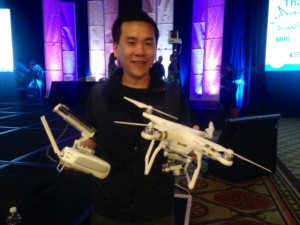Share This
Related Posts
Tags
AIM Highlights
By Leah Etling on May 5, 2015 in Marketing
HUNTINGTON BEACH, Calif. – in a competitive Washington D.C. m ultifamily market, WC Smith released a secret weapon to lease up its 2M property in NoMa: an adorable, social media-savvy English bulldog puppy.
ultifamily market, WC Smith released a secret weapon to lease up its 2M property in NoMa: an adorable, social media-savvy English bulldog puppy.
“Everyone loves pets (in D.C.), but no one has time to take care of them,” said Holli Beckman, Vice President of Marketing and Leasing Operations for WC Smith. Beckman was speaking on a panel focused on creative lease up strategy on Day Two of the 2015 Apartment Internet Marketing Conference.
Joined by Billy Pettit, Senior Vice President of Pillar Properties, and Gianna Negretti, Marketing Account Director at Alliance Residential, the panelists broke down ways to use social media, local business relationships, blogger influence and location as advantageous resources.
Beckman impressed the crowd with the story of Emmy the 2M pup (pictured), who not only acts as a therapy dog for residents of the 2M community, but helped the leasing team get national media attention for the property when a story about her escalated from the D.C. blogosphere to the Huffington Post and the Today Show.
But more important from a leasing perspective, the publicity helped Beckman and her team lease 2M without offering rental concessions, which many competing properties in the neighborhood were using to entice prospects.
Emmy now has nearly 2,000 followers on Instagram and continues to spend her days in the 2M leasing office and nights with the property manager. Residents in need of puppy time can “borrow” her for an hour for a walk or a visit to the on-site dog park.
Capitalizing on a location that may have seemed less than ideal, Pettit shared the approach that Pillar Properties took to lease up Stadium Place, a 500 unit development next to the Seahawks Stadium, but also adjacent to Seattle’s Skid Row.
“We wanted to prove people wrong, to show them that residential housing would work in a neighborhood that had not been traditionally residential,” Pettit said.
They did it in dramatic fashion – PR opportunities included capitalizing on the proximity to CenturyLink Field. A construction crane lifted a pickup truck featuring a Seahawks logo to the top of the building, a giant 12 (for the Seahawks’ 12th man fan base) lit up the building at night, and local TV station KING 5 hosted their New Day morning show from the building’s roof. Seahawks players and coaches joined prospects for an open house party and raved about the property location.
“We took advantage of the unique (locational) opportunities and had a grassroots approach,” Pettit said “be aware of what you have at your disposal. It doesn’t take a lot to build awareness.”
The lease up strategies illustrate a vital aspect of market research that MHN publisher Jack Kern highlighted in a breakfast roundtable Tuesday morning.
“The most essential part of real estate research is the thing that nobody likes to do – talk to people,” Kern says. “Find out who your renter is and what they want. Especially for younger renters, an apartment is the second biggest purchase that people will make, other than a car. They are still years away from buying a house.”
Opening Highlights
You may not yet use a self-flown drone to showcase the latest drought-tolerant landscaping installed at your apartment community, or add a Nest thermostat to a renter’s monthly invoice as an ancillary service. But according to the future-focused multifamily industry experts at the annual Apartment Internet Marketing conference, the day when you will is just around the corner.
Sure, we’ve been hearing talk of aerial photography opportunities and smarter automated apartments for a while, but at the 7th AIM event, a drone was flying in the main ballroom and AIM founder Steve Lefkovits excitedly announced a mass giveaway of August Smart Locks, a digital home access system that turns your smartphone into your house key.
“There are devices that will be entering the market in the next five to ten years that we are not even thinking about,” said Dan Daugherty, CEO of Remotely, speaking on the AIM Connected Home panel on Monday afternoon. “And I think we’re going to make a lot more money, from a community standpoint, than we are making today.”
Many owners in both multifamily and single family are already using smart technology as an ancillary service and as a way to gain business efficiency. Lucas Haldeman, chief technology and marketing officer for Colony American Homes, described how the company’s cellular-based network for its single-family rentals has allowed them to regulate locks and thermostats, all from afar.
“For us it was about macro control of many units,” Haldeman explained. “If I’m (a property manager) in Arizona, I can change the temperature of a home in Texas.”
The result has been large savings in utility bills for empty homes, controlled by remote app; prospects can submit a driver’s license online and receive a one-time, self-service lock code to access a rental they’d l ike to tour; and when a house is rented, residents can pay $20 a month to continue the services.
ike to tour; and when a house is rented, residents can pay $20 a month to continue the services.
For multifamily, the fully automated unit is especially attractive to millennials, Daugherty noted, who want to begin the leasing process with an online tour, execute their lease electronically, and press a button on their smartphone to let in the maintenance staff when a faucet unexpectedly begins to leak.
That online tour, though, was of most relevance to those who listened in rapt attention as Eric Cheng (right), general manager and director of Aerial Photography at DJI, showed off what the latest generation of drones can do.
Without focusing his remarks on the multifamily market, Cheng nevertheless had the audience imagining what a drone that can fly over an active volcano in Iceland or showcase the natural beauty of the Glass Window Bridge in the Bahamas could show off about their communities.
“It’s all about capturing unusual perspectives,” said Cheng, who also demonstrated how 2D and 3D property mapping is made simple with a drone’s assistance. “It’s really exciting to see people be able to leverage the power of maneuvering a camera in space for certain industrial pursuits.”
With regard to the proposed federal guidelines for drone operation that were released in February, Cheng said that prospective flyer-photographers will need a lawyer to aid in obtaining what’s known as a “Section 333 exemption” for permissible commercial use.
However, “there’s tons of precedent and it’s pretty easy to get an exemption,” Cheng said. So expect to see more aerial views of a multifamily community near you.
